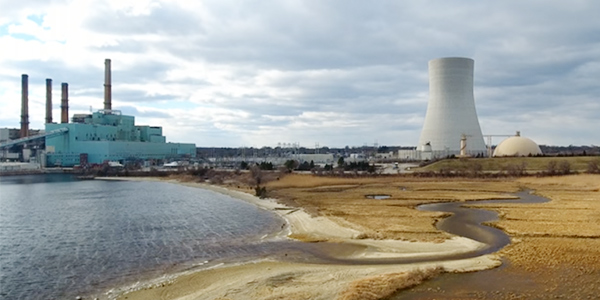By Michael Kuser
FERC on Tuesday clarified on remand that a capacity supplier’s retirement bid can enter ISO-NE’s Forward Capacity Auction if the supplier demonstrates that the bid is just and reasonable, despite contrary assertions by the RTO’s Internal Market Monitor (ER16-551-004).
The D.C. Circuit Court of Appeals on Dec. 28 remanded back to the commission its original October 2017 order accepting ISO-NE’s retirement delist bid mechanism in the FCA (Exelon v. FERC, 17-1275). The court’s action was based on the commission’s own explanation at oral argument that a market participant — and not ISO-NE or the Monitor — has the right to show that its filed rate is just and reasonable and will be entered into an auction regardless of the Monitor’s proposed offer price (ER16-551-003). FERC had until Feb. 1 to respond.
“We see no way to skirt the question Exelon tees up: Under ISO-NE’s new Tariff rules, does a supplier’s rate enter the auction so long as it convinces the commission that the rate is just and reasonable, over contrary claims of the Market Monitor?” the court said.
Ambiguous Language
FERC found that “certain aspects of the relevant Tariff language and the commission’s prior orders interpreting that language are ambiguous.” It ruled that the RTO’s filing must include “the relevant information and justification submitted by both the capacity supplier and the Internal Market Monitor.”
The commission last March approved ISO-NE’s request to reduce the dynamic delist threshold for FCA 13 to $4.30/kW-month from the $5.50/kW-month used in FCAs 10 to 12 (ER18-620). The threshold, which must be revised every three years, is a key parameter for generators considering retirement, which must submit delist bids to opt out of the capacity auction. (See FERC OKs Lower Delist Threshold in ISO-NE.)
“To the extent that the commission’s prior orders in this proceeding can be interpreted as inconsistent with our answers to the court’s remand, we reject those interpretations,” FERC said in the Jan. 29 order, which revised paragraphs 18, 19 and 25 of the Oct. 30 order.
“As the court correctly noted, in the case of a conditional retirement, a mitigated bid is entered into the auction, but the resource will only retire at its originally submitted price,” the commission said. “If the clearing price is below both the original bid and mitigated bid, the unit retires. If the clearing price is at or above both bids, the supplier takes on a capacity obligation. If the clearing price is at or above the mitigated bid but below the original bid, the unit must retire.”
Accepts CASPR Tariff Revisions
In a separate order Tuesday, the commission accepted the RTO’s Tariff revisions to support implementation of the Competitive Auctions with Sponsored Policy Resources (CASPR) rules that the commission accepted in March 2018 (ER19-444). (See Split FERC Approves ISO-NE CASPR Plan.)
“With respect to the test price mechanism, we find that it is a just and reasonable means to address the potential incentive for bid-shading created by the CASPR modifications to the Forward Capacity Market,” the commission said. “Bid-shading” refers to the practice of resources electing to offer their capacity below the RTO’s assessment of their going-forward costs.
ISO-NE filed the Tariff revisions Nov. 30 after FERC on July 2 denied a Tariff waiver to allow the RTO to enter a cost-of-service agreement to keep Exelon’s 2,274-MW Mystic plant running after its capacity supply obligations (CSOs) expire in May 2022. The commission instead directed the RTO to revise its rules to allow such agreements in order to address fuel security. (See FERC Denies ISO-NE Mystic Waiver, Orders Tariff Changes.)
‘Confounding Interpretation’
In a partial dissent, Commissioner Richard Glick said the RTO seemed to be working at cross-purposes to the stated mission of CASPR’s substitution auction to provide state-sponsored resources subject to a minimum offer price rule (MOPR) a chance to purchase a CSO — and the associated revenue stream — from a resource that then retires from the market.
“ISO-NE adopted what can only be described as a confounding interpretation of what qualifies as a state-sponsored resource,” Glick said, referring to a provision requiring the resource be located within a state’s geographical boundaries.
“Specifically, the [RTO] concluded that an offshore wind facility that is procured pursuant to a state-mandated solicitation and that is electrically located in that state does not qualify as a state-sponsored resource for the purpose of the renewable technology resource exemption (RTR) to the MOPR, which CASPR retained as a transition mechanism to the fully fledged substitution auction,” he said.
Glick characterized the RTO’s interpretation as “discouraging” and as putting up “an unnecessary barrier to the type of resources that CASPR was supposed to accommodate.”
The RTO also proposed to bar from the substitution auction resources that bid-shade even if those resources clear the capacity construct and receive a CSO. Glick said the “unambiguous result” of that change “will be to again tilt the scales in favor of retaining traditional resources and against the incorporation of state-sponsored resources. As a result of this proposal, a resource that might otherwise retire through the substitution auction will instead remain in the market, holding a CSO that it could have sold to a state-sponsored resource.”




